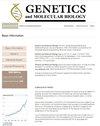Expression profile of inflammasome genes in individuals with Down syndrome.
IF 1.3
4区 生物学
Q4 BIOCHEMISTRY & MOLECULAR BIOLOGY
引用次数: 0
Abstract
Down syndrome (DS), affecting 1 in 700 live births, is the most prevalent chromosomal disorder among newborns. Recognizable by classical clinical features, patients with DS are susceptible to various immunological misbalances. Inflammasome is (mis)activated in several immune-mediated diseases, however studies on individuals with DS are lacking. The present study evaluated the gene expression of NLRP1, NLRP3 and IL-1β in individuals with DS, aiming to understand their susceptibility to immune-mediated diseases. In addition, we assessed whether the individuals with DS present a differential inflammatory response after in vitro infection using PBMCs. For the gene expression assay, 20 individuals with DS and 15 healthy individuals for the control group (CT) were included, while the in vitro infection assay included 10 subjects. mRNA levels from individuals with DS group showed 1.9-fold change (FC) downregulation for NLRP1 (p=0.0001), but no differences for NLRP3 and IL1β. We did not observe significant differences between lipopolysaccharide (LPS)-treated and untreated cells in our in vitro assays. The differential expression of NLRP1 in individuals with DS suggests a potential association with susceptibility to the development of immune-mediated diseases, but further analysis is needed to confirm this relationship.唐氏综合征患者炎症小体基因的表达谱。
每 700 个活产婴儿中就有 1 个患有唐氏综合征(DS),它是新生儿中最常见的染色体疾病。唐氏综合征患者具有典型的临床特征,容易出现各种免疫失调。炎症小体在多种免疫介导疾病中被错误激活,但对 DS 患者的研究还很缺乏。本研究评估了 DS 患者 NLRP1、NLRP3 和 IL-1β 的基因表达,旨在了解他们对免疫介导疾病的易感性。此外,我们还利用 PBMCs 评估了 DS 患者在体外感染后是否会出现不同的炎症反应。在基因表达检测中,对照组(CT)包括20名DS患者和15名健康人,体外感染检测包括10名受试者。DS患者组的mRNA水平显示NLRP1下调了1.9倍(FC)(P=0.0001),但NLRP3和IL1β没有差异。在体外试验中,我们没有观察到脂多糖(LPS)处理细胞与未处理细胞之间的明显差异。NLRP1在DS患者中的不同表达表明,它可能与免疫介导疾病的易感性有关,但还需要进一步的分析来证实这种关系。
本文章由计算机程序翻译,如有差异,请以英文原文为准。
求助全文
约1分钟内获得全文
求助全文
来源期刊

Genetics and Molecular Biology
生物-生化与分子生物学
CiteScore
4.20
自引率
4.80%
发文量
111
审稿时长
3 months
期刊介绍:
Genetics and Molecular Biology (formerly named Revista Brasileira de Genética/Brazilian Journal of Genetics - ISSN 0100-8455) is published by the Sociedade Brasileira de Genética (Brazilian Society of Genetics).
The Journal considers contributions that present the results of original research in genetics, evolution and related scientific disciplines. Manuscripts presenting methods and applications only, without an analysis of genetic data, will not be considered.
 求助内容:
求助内容: 应助结果提醒方式:
应助结果提醒方式:


